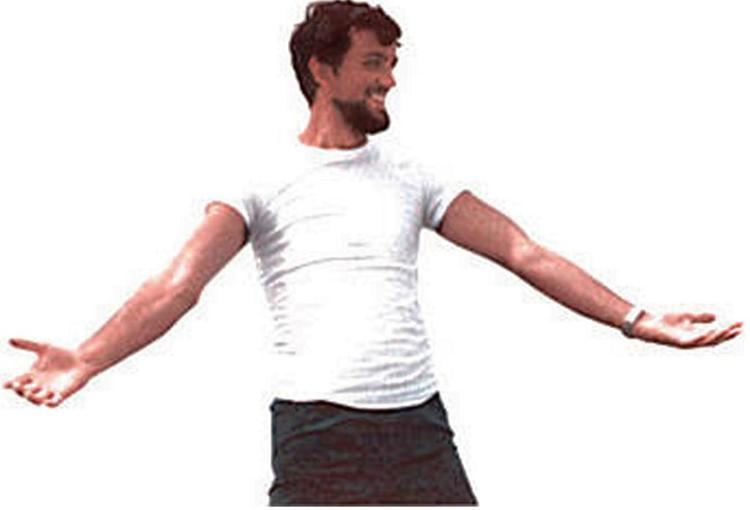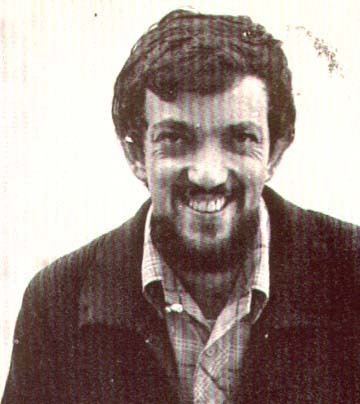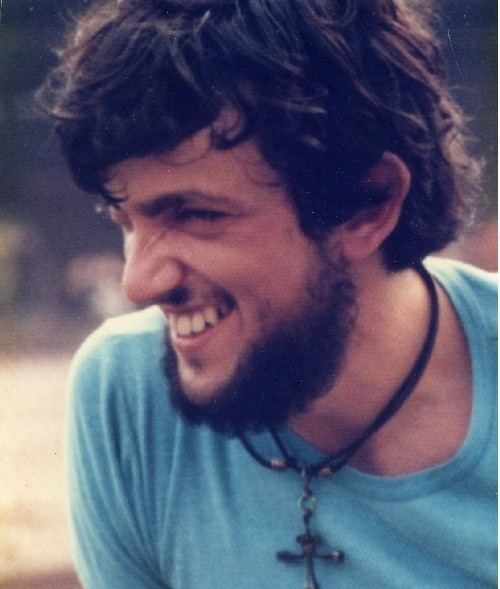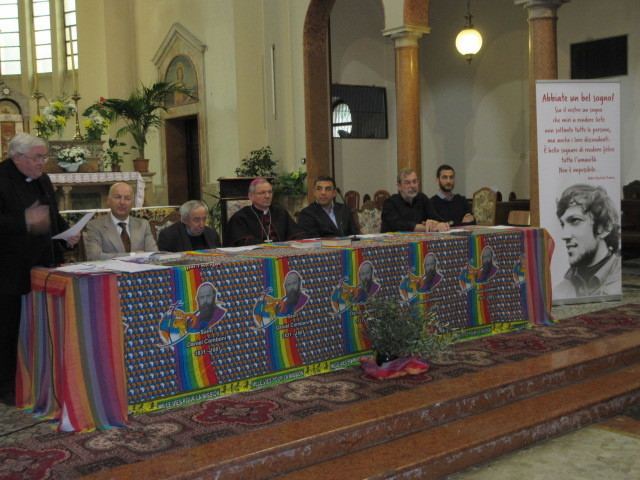Other names Lele; Ezequiel Role Missionary Name Ezechiele Ramin | Ordained September 28, 1980 Church Roman Catholic | |
 | ||
Education | ||
Ezechiele ramin martire per la scelta dei poveri
Father Ezechiele Ramin M.C.C.I. (Padua, Italy, 9 February 1953 - Ji-Paraná, Rondônia, Brazil, 24 July 1985), familiarly known as "Lele" in Italy and "Ezequiel" in Brazil, was an Italian Comboni missionary and artist who was described as a martyr of charity by Pope John Paul II after his murder in Brazil while defending the rights of the farmers and the Suruí natives of the Rondônia area against the local landowners.
Contents
- Ezechiele ramin martire per la scelta dei poveri
- Padre ezechiele ramin beato e martire la parola a roma
- Life
- Cacoal
- Death and aftermath
- Other activities
- Tributes
- Beatification cause
- References

Padre ezechiele ramin beato e martire la parola a roma
Life

Ezechiele Ramin was born in Padua (in the Veneto region of Italy) in 1953, the fourth of six sons in a modest family. He studied at a Liceo classico in a Catholic school (Collegio Vescovile Gregorio Barbarigo) where he became aware of the poverty widespread throughout the world. This pushed him to join the charity Mani Tese ("Outstretched Hands"), organising several camps to collect funds in order to support small projects related to the association.

In 1972, he decided to join the religious institute of the Comboni Missionaries of the Heart of Jesus; his studies brought him to move first to Florence, then to Venegono Inferiore (in the Province of Varese) and finally to Chicago, where he graduated from Catholic Theological Union and served in the St. Ludmila Parish. After having experienced missionary work with impoverished Native Americans in South Dakota and later, for one year, in Baja California (Mexico), he was ordained a priest on 28 September 1980 in his native Padua. He was assigned to a parish in Naples but, following the 1980 Irpinia earthquake, he moved to San Mango sul Calore to assist the victims; he returned to Naples in 1981 where he organised one of the first pacific demonstrations against camorra. The following year he moved to Troia in Apulia, where he acted as a focal point for vocational groups.
Cacoal

In 1984, he was assigned to Cacoal, in Rondônia (Brazil). On January 20, 1984, he moved to Brasília, where he underwent further education in pastoral care, and finally reached Rondônia in July of that year.
He seemed wary of the situation in Cacoal, but accepted his assignment with the words "If Christ needs me, how can I refuse?"

There he encountered a difficult situation: the many small farmers of the area were oppressed, through both legal and illegal actions, by the local landowners. Also, the indigenous Suruí tribes had only recently been forced to become sedentary by being allocated land by the Brazilian government and were growing restless.

Inspired by the teachings of Dietrich Bonhoeffer, he put himself to the front in their struggle for justice, trying to lead them to a pacific protest rather than to start an armed revolution.

The situation he was in brought him to fear for his life. In early 1985 he was threatened of being killed; in many of the letters he wrote to his family in that year he wonders if he will ever see them again.
Death and aftermath
On 24 July 1985, Father Ramin, alongside the local trade union leader Adilio de Souza, chaired a meeting in Fazenda Catuva in Ji-Paraná, in the nearby state of Rondônia, trying to persuade the small farmers employed there to avoid taking arms against the landowners, going against a request of caution issued by his superiors. On his way back with de Souza, at midday, he was attacked by seven pistoleros (hired gunmen) who shot him more than 50 times. Before dying, he whispered the words "I forgive you". As Father Ramin's body couldn't be recovered by his fellow missionaries for about 24 hours after his death, a group of Suruí indios kept vigil until their arrival.
He was buried in the Padua Cemetery.
Some days after the event Pope John Paul II defined Father Ezechiele Ramin a "martyr of charity".
Dom Ivo Lorscheiter, the then-President of CNBB (the National Conference of Brazilian Bishops), took inspiration from Father Ramin's murder to urge the Brazilian society to drive towards a deep "structural change".
The reaction to Father Ramin's murder by the local farmers went against his teachings: in November of the same year a landowner and his general manager were killed by the same people Father Ramin had been trying to help, and some days later another farm manager was shot.
In 1988, two of the men who shot Father Ramin - Deuzelio Goncalves Fraga and Altamiro Flauzino - were condemned to respectively 24 and 25 years' imprisonment by the Cuiabá tribunal. Others have not been identified nor arrested.
Some years after Father Ramin's death another Comboni priest from Padua, Father Pietro Settin, visited the area where Ramin was murdered discovering that Adilio de Souza, the union leader who had been with Father Ramin on the day of his death, had become the owner of a piece of land. Father Settin theorized that he might have received it in exchange for betraying Father Ramin.
Other activities
Father Ezechiele Ramin's main hobbies were cycling and playing football; he also wrote poetry. His numerous letters to his friends and family were collected and published in a volume edited by Ercole Ongaro and by Father Ramin's brother Fabiano, entitled Testimone della speranza - lettere dal 1971 al 1985 (Witness of Hope - Letters 1971 - 1985). Several of them (in Italian) are publicly available.
He also produced a consistent number of drawings, especially in charcoal, that were subject of an exhibition held in 2010 in his native city of Padua, promoted by the local Comune (municipality) and organised by Maria Cristina Ferin, Federica Millozzi and Fabiano Ramin. Several of them had already been collected in a book and published.
He also liked to document his experiences through photography.
Tributes
Several initiatives in honour of Father Ezechiele Ramin are regularly held both in his native Padua and in Cacoal, mostly linked to promote peaceful protest instead of armed revolution and to awaken the young people's awareness and interest in the missionary world.
In 2005 - the twentieth anniversary of his death - he was remembered by Padua Bishop Antonio Mattiazzo in an initiative about modern martyrs; in the same year, a bronze sculpture by Ettore Grego in Father Ezechiele's memory was unveiled by Padua Mayor Flavio Zanonato in Piazza San Giuseppe, in front of the church Father Ramin used to frequent as a child and a young man.
Again in 2005, Catholic Theological Union in Chicago, where Father Ramin studied, commissioned an icon bearing Father Ezechiele's image to the renowned icon painter Robert Lentz, who represented Father Ramin with a turtle dove to symbolise his belief in nonviolence. The presence of a halo around Father Ezechiele's head is, however, improper according to the Catholic iconography, as Father Ramin has not been officially recognised as a Saint. Lentz, however, has often added halos to icons representing martyrs not conventionally recognised as saints such as Albert Einstein, César Chávez and Heȟáka Sápa (Black Elk).
In 2010 he and Sister Dorothy Stang were chosen by the Comboni missionaries in Brazil as symbols of the local people's struggle for land ownership.
Besides a collection of his letters to friends and family, three further books about Father Ramin's life have been published: Lele - creare primavera (Lele - Creating Spring), by Ezio Sorio, Lele vive (Lele Is Alive), by Paulo Lima (2005) and Ezechiele Ramin: la forza di una testimonianza (Ezechiele Ramin: the Strength of a Witness) by fellow Comboni missionary Giovanni Munari.
In 1998 RAI, the Italian national television network, commissioned La casa bruciata, a TV movie inspired by Father Ezechiele Ramin's life. It was directed by Massimo Spano with a soundtrack by Ennio Morricone and featuring Giulio Scarpati.
In late 2011 a musical reading of selected passages from Ezechiele Ramin testimone della speranza. Lettere e scritti 1971 – 1985 was organized in Padova in occasion of Human Rights Day with the participation of actor Andrea Pennacchi and of the international "music collective" Luomodellazappa.
Two Italian Comuni named a street after Father Ezechiele Ramin: Padua, the city of his birth, and Rome.
Cadoneghe, in the province of Padua, entitled an auditorium to Father Ramin.
Padua entitled to Father Ramin a nursery school.
Again in Padua, the non-profit association Angoli di Mondo (Corners of the World) opened a public information centre, the Centro di Documentazione Ezechiele Ramin.
The parish of Saint Richard of Andria in Andria (in Apulia) dedicated its meeting and recreation room to Father Ezechiele Ramin.
In Brazil, in Picos (Piauí), the Angoli di Mondo association supported the building and activation of a day care centre for street children that was entitled to Father Ramin.
Beatification cause
The Comboni missionaries, led by Superior General Father Teresino Serra, are trying to put forward a cause for Father Ezechiele's martyrdom (and therefore his status as a Blessed and possibly as a Saint) to be formally recognised by the Catholic Church, although if for the Comboni missionary community in Latin America "for them and the people who knew him, Ramin is already a saint".
He is considered a "witness of the faith".
